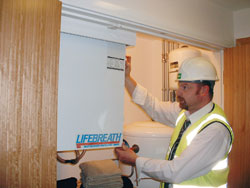The air conditioning industry has had to defend itself as it is relentlessly attacked over increasing CO2 emissions. We can all be public relations officers for the products. We have a lot of ammunition and we should use it. Andy Stamford, managing director of Wave Air
Conditioning, begins the fight back.
WHENEVER there is a report on climate change, such as the Stern Report, the media finds someone to attack the big bad air conditioning industry. It is quite right that they attack the growth of CO2 emissions through increased use of energy, and they should have our full support.
However, when are they going to stop picking on air conditioning and give the industry credit for the progress it has made during the last 30 years?
During that time, it has changed enormously for the ‘greener’; partially because of pressure from legislators, but also because it took a good hard look at itself.
During the last three decades, we have made huge strides; starting with the move away from CFCs to increasingly more benign refrigerants. Even before the full effect of the new F-Gas Regulation has been felt, it is being reported that the ozone layer is repairing itself.
The ozone layer grabbed the headlines in the late ’80s but global warming, caused by CO2 emissions, was always the greater problem.
While the world’s scientists continued to argue about its cause, and even if it existed at all, the international air conditioning industry just got on with the job of reducing carbon emissions through increased efficiency. New equipment now uses about a third less power than 10 years ago.
Obviously, this was not done exclusively for the sake of the planet, but partly to give manufacturers a commercial edge by offering end users lower running costs, but the effect was lower CO2 emissions and the industry should get credit for that.
The biggest leap forward was the inverter drive. Previously equipment was either full on or off. The inverter matched power requirement to output exactly, which means electricity is never wasted. It also takes less energy to start up than traditional equipment.
Another advance has been the development and spread of the heat pump, which allows efficiently generated heat to be provided by the same unit as comfort cooling. This can be used either as a building’s main heating system – eliminating the need for a wet system – or to provide a boost to an existing system, especially when combined with an inverter.
With a nudge from the Part L Building Regulations, the majority of new equipment produced by the major manufacturers is now “A” rated for energy efficiency. Most units we sell are now on the Carbon Trust’s Enhanced Capital Allowance (ECA) list, which lets end users receive tax rebates for installing efficient equipment.
Other associated technologies are also boosting efficiency. Our sister company, Wave Heat Recovery, supplies equipment to properly ventilate virtually air tight Super E buildings, while minimising heat loss.
During the winter, the Lifebreath units in the ventilation system return about 80% of outgoing heat to the dwelling. During the summer, they do the same with cool air.
If we are to maximise efficiency fully, and win the environmental PR battle, it is not enough for those who are planning installations to just look at air conditioning; they also need to look at heat recovery, insulation and the finding and elimination of building air leaks through blower door testing. It is the building we want to heat or cool, not the environment.

Wave's mark Lister installing a Lifebreath unit in one of the 147 new homes to receive them at a housing development in Holborough, Kent
We cannot afford to rest on our laurels. If we are to avoid coming under more pressure from the environmental lobby, we have to maintain and improve overall levels of efficiency. Two things can impede this: poor service and maintenance and cheap imports.
It may seem a cheek for someone who makes a living out of distributing imported equipment to complain about imports, but there are imports and imports.
There has been a glut of equipment coming in from countries with little history of manufacturing quality. These units are sold on price alone, with little regard for efficiency or life expectancy.
Many wholesalers and contractors are tempted to try to win customers by offering this equipment, but increased running and maintenance costs and more frequent breakdowns result in dissatisfied customers in the long run.
Another trend that could cause similar problems is the current drive by some Continental wholesalers to take advantage of this country’s reasonable margins, as opposed to the cutthroat levels in the rest of Europe.
Although their equipment is as sound as any supplied by UK based distributors, the support they offer is not.
Spurred on by demanding end users, environmentalists, tight planning regulations and the need to adapt to the idiosyncrasies of a high proportion of older buildings (designed before air conditioning was considered), we have built up a skill-base and support network in this country that is second to none.
Only a proportion of our time as a distributor is spent buying and selling, much is spent on planning, designing, commissioning, and providing help, information and advice – that is the reason for higher UK margins.
Some contractors, who have been tempted by small savings, have found themselves with big problems and unhappy customers when things have not gone straightforwardly, and the only support they have is a helpline number that rings in an office 600 miles away.
It is important contractors understand why it is vital for the industry as a whole to maintain sensible margins. Without them, the support will disappear, contractor service will diminish and efficiency will fall. We should not be taking risks of this sort, when every green eye in the country is watching us.